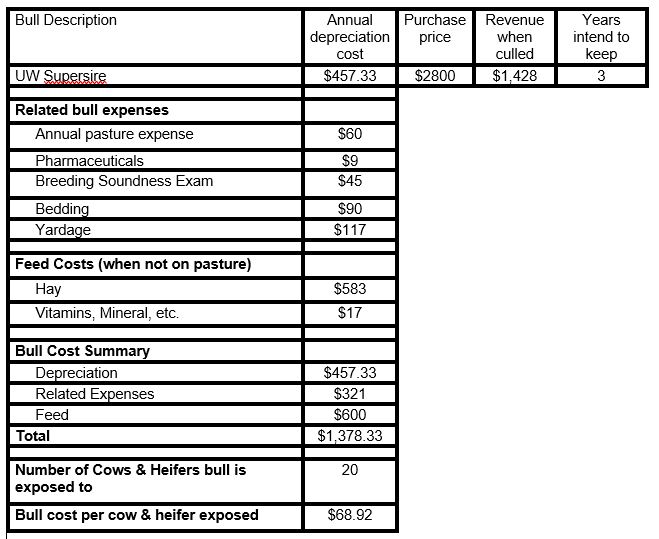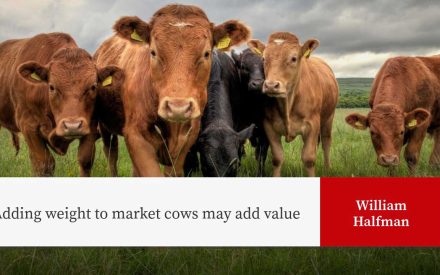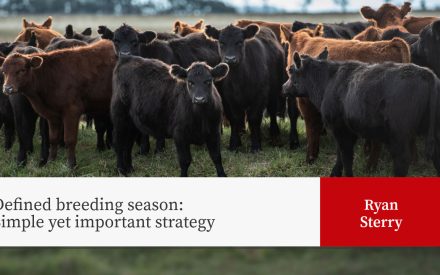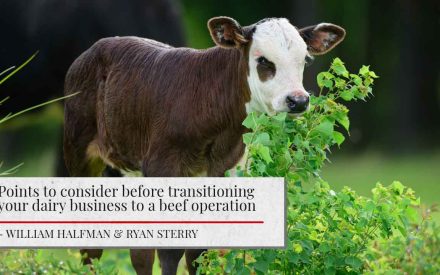Fertility is a major factor in determining beef cow calf herd profitability. Breeding expenses can be viewed as a double-edged sword. Cheaper is not always better, especially if resulting in reduced fertility or less desirable calves at sale time. More expensive options are not always better either, requiring a corresponding benefit to fertility, calf performance, or marketability.
Artificial insemination (A.I.) expenses are a cash expense that can be tracked relatively easily: semen cost per unit, total number of units used, arm service fees, and synchronization costs (if applicable). Unpaid labor for cattle handling and estrus detection, and expenses for cattle handling facilities to facilitate A.I., can be a little more difficult to track. However, by tracking labor hours and handling facility depreciation these expenses can be determined.
Determining the true costs for natural service bulls can be a different story. Too often producers only consider the bull’s purchase price, without factoring related bull ownership expenses. These other costs can be challenging to benchmark because they are farm specific and vary with market conditions. For example, feed prices and cull bull income vary yearly with market prices. Other expenses the herd bull comes with include feed; veterinary and health products; yardage expenses when not on pasture; and pasture related expenses (their share of fencing, seeding, and pasture rent).
How these expenses are divided across the herd is farm specific, depending on how many bulls you intend to keep, years of ownership before culling, and the number of females covered per bull. For example, stretching a bull across more cows may initially appear to make economic sense, but in actuality this decision should be based upon bull’s capacity. The number of females per bull should be based on recommendations that take into account the bull’s age and range conditions. Herd size is an additional factor for consideration, especially for smaller herds having fewer cows to spread their bull expenses across.
Here is an example of how a bull budget may look.
This example budget can be taken one step further and analyzed on cost per calf weaned. If 90% of the herd becomes pregnant (18 of 20 cows), and 17 of 18 cows wean a calf, the bull cost per weaned calf is $81.08.
These figures are presented for discussion purposes only. We highly encourage you to calculate costs for your own farm.
Herd bulls are a significant investment for the beef cow-calf enterprise. Treat them as such. This means implementing good management practices for herd sires, particularly in preparation for breeding season. Poor bull fertility results in greater economic losses than female fertility, considering one bull has influence over several females. Examples include monitoring bull body condition scores, having breeding soundness exams conducted, and keeping herd sires up to date on vaccinations and health protocols. Monitor bull locomotion for any issues. Incidental foot and leg problems should be treated before breeding season. Bulls with chronic foot and leg issues, disposition issues, or too easily lose body condition are good candidates for early culling
Extension’s replacement heifer budget tool helps producers make informed management decisions for raising replacement heifers and includes a bull expense calculator. Additional resources for successful management of your beef operation are available by contacting your local Extension Educator.
Reviewed by: Amanda Cauffman and Bill Halfman, UW-Madison Division of Extension Educators in Grant and Monroe Counties


 Adding weight to market cows may add value
Adding weight to market cows may add value Defined breeding season: Simple yet important strategy
Defined breeding season: Simple yet important strategy 🎧 LISTEN: Points to consider before transitioning your dairy business to a beef operation
🎧 LISTEN: Points to consider before transitioning your dairy business to a beef operation Using Genomics as a Decision-Making Tool for Commercial Replacement Heifers
Using Genomics as a Decision-Making Tool for Commercial Replacement Heifers


